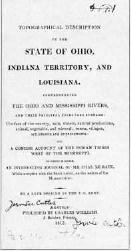The Journal of Charles LeRaye

Title page of A Topographical Description of the State of Ohio, Indiana Territory, And Louisiana
The appended journal was a captivity narrative. It described the adventures of Charles Le Raye, who was described as a French trader from Canada. In 1801 he had apparently travelled to southwest Missouri to trade, but was captured by a band of Teton Sioux. As a captive, he was taken far up the Missouri River, visiting Indian villages such as those of the Arikara and Mandan tribes where Europeans had never been before, and then southwest to the headwaters of the Yellowstone River. He finally managed to escape, and arrived back in the lower Missouri in 1805. He spent eighteen months recovering from his captivity, and it was during this time that he purportedly wrote the narrative of his captivity.
If Le Raye's narrative is true, it would be an extremely valuable anthropological resource. It would contain the earliest recorded information on the Arikara, Mandan, and Western Sioux peoples. Also if the narrative is true, it would mean that Le Raye had preceded the Lewis and Clark expedition into the Upper Missouri and Yellowstone regions by three years, and that he would have been the first to write an account of that area.
Le Raye's journal received little attention during the nineteenth century, but during the twentieth century more scholars began to take notice of it, and as they did so, doubts began to be raised about its authenticity. These doubts prompted the historian Clyde Dollar to examine the document more closely. Dollar concluded that the narrative was a hoax, and that Charles Le Raye himself probably never existed at all.
Some of the evidence Dollar offers to support his conclusion includes the gross geographical inaccuracies that run throughout the narrative, as well as Le Raye's apparent lack of knowledge about various aspects of Indian life. For instance, Le Raye refers to the stabling of horses inside a Sioux tipi and describes Arikara earth lodges that could not possibly stand. As for Le Raye himself, Dollar notes that except for the man's authorship of the captivity narrative, not a single reference to his existence seems to remain anywhere else, in any archive.
What makes the narrative interesting, however, are not its many inaccuracies, but rather the few instances of accurate information that it contains. This information could only have been obtained by someone who was familiar with the peoples of the Upper Missouri region, but it is not contained in any of the known sources that would have been available to someone around 1810. Dollar suggests that if Sergeant Nathaniel Pryor, a member of the Lewis and Clark expedition, had kept a record of his travels, this might have been able to provide the author of Le Raye's journal with all the necessary information, since Pryor visited all the areas described by Le Raye. However, a journal kept by Pryor has not previously been known to exist. Le Raye's narrative, however, suggests that Pryor might indeed have kept a journal, and that it waits to be found.
References/Further Reading:
- Dollar, Clyde D. "The Journal Of Charles Leraye: Authentic Or Not?", South Dakota Historical Collections, 1982 (41): 67-191.
| Main Page | Search |
Back to Gallery: 1800-1868 |